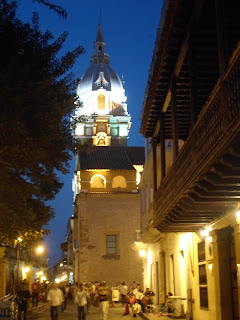Cartagena de Indias, one of the most
beautiful cities in the World! Designated a World UNESCO Heritage Site in 1984.
It has the most extensive fortress in Latin America, that was built in order to
protect the city from the constant pirate attacks and attempts to conquer the
city by British, Americans or French.
 |
| Part of the fortress seen from the shore. In the evening, at around 6 p.m. people watch the sunset from the wall. |
The history of this city is very rich, but
also full of sorrow. It has suffered a lot during the centuries and also has
been one of the greatest cities of Latin America. It was one of the most important
ports in the New World, where the metals and slaves were traded. Most of the
buildings have been built by slaves, e.g. the fortress wall. Along with Veracruz in Mexico, it was
designated the only port to trade the African slaves in Latin America. In the
beginning of XVII century the Spanish Crown has established an Inquisition
Court, which currently serves as a historical museum of the city and
inquisition. Many people have been killed for the heresy and for magical
practices. Many sophisticated machines have been invented to torture the
suspects that can be viewed in the museum. The suspects also were burnt at the
stake or hanged on public gallows.
 |
| View on the Naval Museum and San Pedro Claver church in the background |
The history of Cartagena begun early, as
archeologists estimate it - 4000 A.c..
The tribes from the Carib family language
habited the region around the year 1500, which they called Kalamary. About all
this you can learn in the Naval History of Cartagena, a good source of
information about the region, but if you don’t understand Spanish you rather
read the history on your own. Everything is written in Spanish, unfortunately.
 |
| The Cathedral |
An important mark on the city left Francis
Drake, when he conquered Cartagena in 1586. He has appropriated an amount of
107.000 Spanish eight reales, which currently is an equivalent of 200.000 US
dollars and destroyed a quarter of the city, along with a part of recently
built cathedral. The very same cathedral can be viewed today, but the access is
not free. It is after this attack, the Spanish crown decided to build a
fortress to protect the city.
Nineteenth century has been tough as well. The
independence has been signed on the 11th of November 1811. Cartagena at that time has become the
capital of the newly founded country called New Granada. Thirty years later an
epidemic of Cholera broke, reducing the population number, one third of the
people died. The city has been nearly destroyed, and on top of that it was
stroke by famine. It resembled a ghost town during this period.
The contemporary Cartagena shines in its
beauty, the restored to splendor Walled City (La Ciudad Amurallada) amazes the
visitors. The vibrant colours of the buildings, architecture, friendly locals,
the Afro-Caribbean culture at its best.
 |
| Modern Bocagrande in the background |
 |
| One of the lovely streets in Cartagena |
The most popular music genres are cumbia
and vallenato, the instruments that are popular are accordion, drums and guiro
(looks like a big grater). We have participated in a Colombian private street
party. After winning the match with Bolivia a group of friends have been
celebrating for three days, drinking and dancing outside their house. When
walking on the beach in Bocagrande (part of Cartagena, where all the
skyscrapers are), we saw musicians playing music for particular people who were
chilling on the beach, who were then dancing and singing along with the
musicians. Colombians know how to have fun.

No comments:
Post a Comment